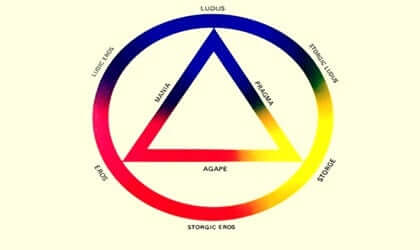There are different types of love, according to John Allan Lee. To differentiate them, this author is part of the idea that, as with colors, there are three types of primary affections that, when mixed, give rise to three others.
This approach, which emerged in the 1970s, reminds us of very important aspects: we all need basic nutrients, such as respect, companionship and passion to be happy.
- Before detailing this theory.
- It is interesting to talk about its author.
- Who although his name is not well known.
- It can be said that he was one of those figures who combined social activism and academic research like no other.
- He was a renowned sociologist at the University of Toronto.
- Who spent his whole life studying the psychological aspects of love and sexuality.
John Allan Lee was a trade unionist, social activist at Amnesty International, an advocate for the rights of the LGBT community and also one of the most wrestlers for the right to die or aid in suicide, in fact, he chose this end for his life when the time came. He left this world alone after writing his memoirs and understanding that he had achieved his goal: to defend the importance of love and respect among people.
“Love is red, blue and yellow. ” ? John Allan Lee?
More can be learned about the different types of love according to John Allan Lee through a book and study that the author himself published after several years of work and analysis at the University of Toronto, Canada. In his work “The Colors of Love”, he begins by saying that the most authentic and rewarding love is blue, red and yellow.
These three basic or primary colors, when mixed, can give rise to new and fascinating tones, to other types of love, however, in terms of affection, nothing is as important as the primary base consisting of the following dimensions:
Below are the secondary archetypes that set the love types according to John Allan Lee.
Eros clearly defines romantic love. In this case, we have this bond idealized and promoted by our culture, in which passion and emotional devotion are the source of often harmful bonds, attraction is intense and immediate, and attention is paid to physical appearance, absolute devotion and possession.
Eroticism, context that has its roots in the Greek era, shapes this love oriented exclusively to desire and sexual act; In John Allan Lee’s theory of types of love, this typology deserves attention for a very simple reason: through these sexual encounters without an emotional component, a stable and even satisfying relationship is not always consolidated.
While these sex games initially, these encounters based on unexpected physical attraction are rewarding for both, in the long run they can bring disappointment or simply fulfill their specific task, leading to the search for new sexual partners.
People with a playful style in their emotional relationships see love as a game, their goal is to conquer, to obtain benefits (emotional, sexual, fun?). Therefore, to achieve their goal, they do not hesitate to seduce, deceive and manipulate. They do not enter into relationships or establish emotionally distant relationships.
“Playful” individuals, according to John Allan Lee’s type of love theory, focus only on short-term benefits.
In this type of love we have people who are governed by a sense of logic, re-delight emotions to the background and focus solely on the usefulness of emotional relationships, in this way the most pragmatic often wonder if their potential partner would be accepted. by family and friends. They also wonder if, with that person, they will achieve financial stability or whether they will be someone who will affect their peace of mind and personal balance.
The obsessive style of love is present in these dependent people and focuses solely on meeting their own needs, they are profiles with great emotional oscillations, sometimes cold and then passionate, they are possessive, jealous, controlling and can even abuse.
In this last dimension of love types, according to John Allan Lee, we have a bond that can bring us happiness. They are people who know how to “give and receive”. They are profiles that focus on the needs of your partner, that offer your affection unconditionally, that are committed, that care and care, that work in a bond based on satisfaction and harmony.
In conclusion, we can say that these 6 subtypes usually appear combined and intertwined in our emotional relationships, whether we like it or not, there is always a component of eros, erotic, and a good substrate of this agape on which to work on a daily basis.
We need to know what typology is most present in us or among our partners to maintain this archetype or, on the contrary, work it in case we are on the path of obsession or excessive pragmatism.

